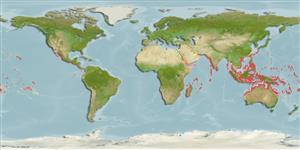Common names from other countries
>
Ovalentaria/misc (Various families in series Ovalentaria) >
Plesiopidae (Roundheads) > Plesiopinae
Etymology: Plesiops: Greek, plesios = near + Greek, ops = appearance (Ref. 45335); coeruleolineatus: Species name refers to the blue lines present in the dorsal and anal fins..
More on author: Rüppell.
Environment: milieu / climate zone / depth range / distribution range
Ecologia
marinhas associadas(os) a recifes; intervalo de profundidade 1 - 23 m (Ref. 9710), usually 3 - 23 m (Ref. 27115). Tropical; 23°C - 27°C (Ref. 130632); 30°N - 30°S
Indo-Pacific: Red Sea and East Africa to Japan and Oceania.
Tamanho / Peso / Idade
Maturity: Lm ? range ? - ? cm
Max length : 10.0 cm TL macho/indeterminado; (Ref. 30874)
Espinhos dorsais (total) : 10 - 12; Raios dorsais (total) : 6 - 8; Espinhos anais: 3; Raios anais : 8. Color variable; body generally black or brown; 2 dark stripes behind eye; dorsal spines orange distally; bluish stripe along basal part of dorsal fin (Ref. 5473).
Adults are found under stone or corals in flood basins and lagoons (Ref. 9137). They are common but very secretive and usually found when turning rubble pieces in pools (Ref. 48635). They venture out in the open at night to feed on small crustaceans, fishes and gastropods (Ref. 37816). Eggs are guarded by the male parent (Ref. 205). Minimum depth reported from Ref. 30874.
Ciclo de vida ou comportamento de acasalamento
Maturities | Reprodução | Spawnings | Egg(s) | Fecundities | Larvas
Eggs are guarded by the male parent (Ref. 205).
Mooi, R.D., 1995. Revision, phylogeny, and discussion of biology and biogeography of the fish genus Plesiops (Perciformes: Plesiopsidae). Life Sci. Contrib. No. 159, 108 p. (Ref. 27772)
Status na Lista Vermelha da UICN (Ref. 130435)
CITES (Ref. 128078)
Not Evaluated
Ameaça para os humanos
Harmless
Uso pelos humanos
Pescarias: sem interesse; Aquário: Espécies comerciais
Ferramentas
Relatórios especiais
Baixar XML
Fontes da internet
Estimates based on models
Preferred temperature (Ref.
115969): 24.8 - 29, mean 27.8 (based on 954 cells).
Índice de diversidade filogenética (Ref.
82804): PD
50 = 0.5000 [Uniqueness, from 0.5 = low to 2.0 = high].
Bayesian length-weight: a=0.00468 (0.00177 - 0.01234), b=3.18 (2.95 - 3.41), in cm Total Length, based on LWR estimates for this (Sub)family-body shape (Ref.
93245).
Nível Trófico (Ref.
69278): 3.6 ±0.3 se; based on diet studies.
Resiliência (Ref.
120179): Elevada, tempo mínimo de duplicação da população menor que 15 meses (Preliminary K or Fecundity.).
Fishing Vulnerability (Ref.
59153): Low vulnerability (10 of 100).
